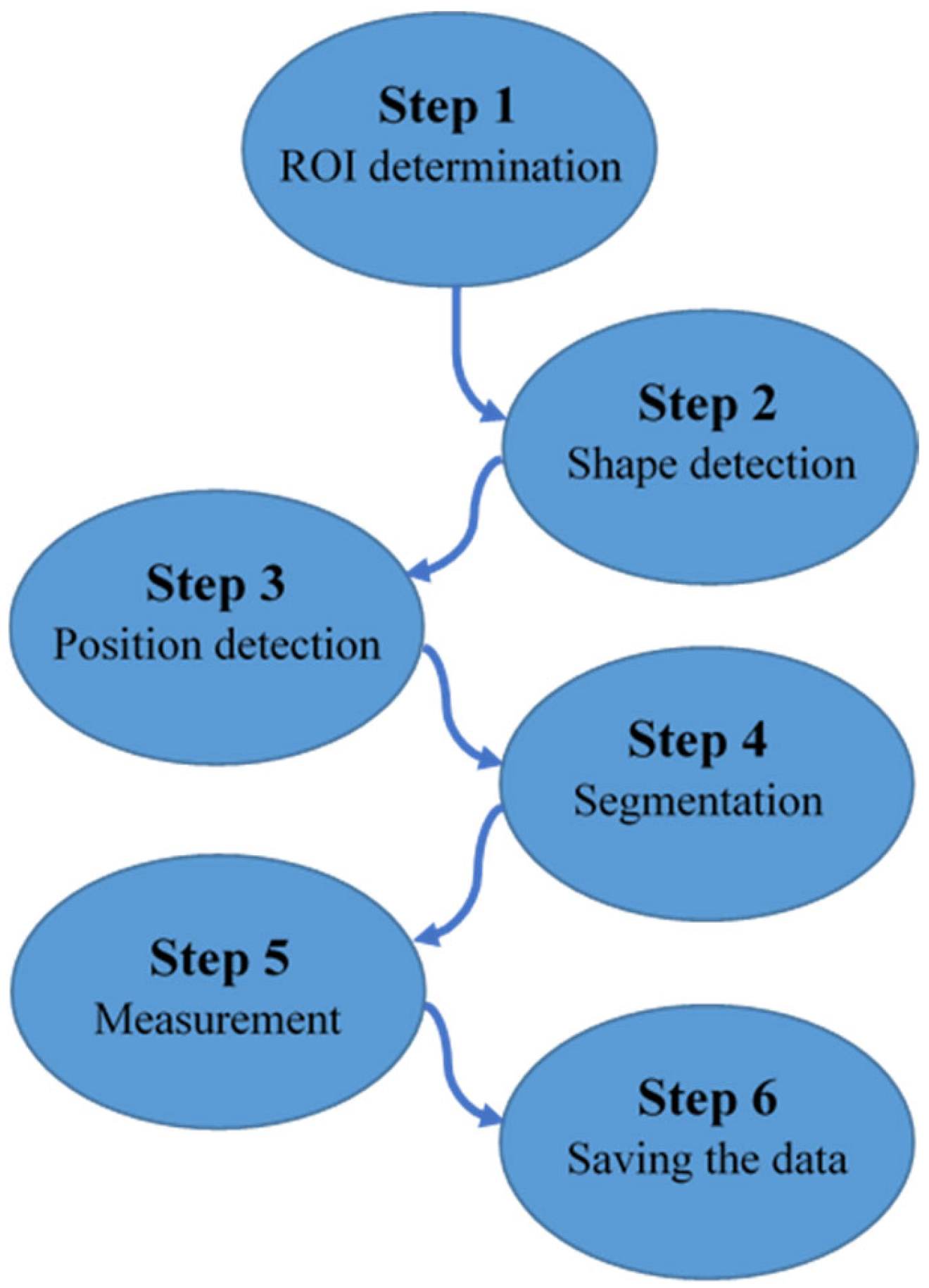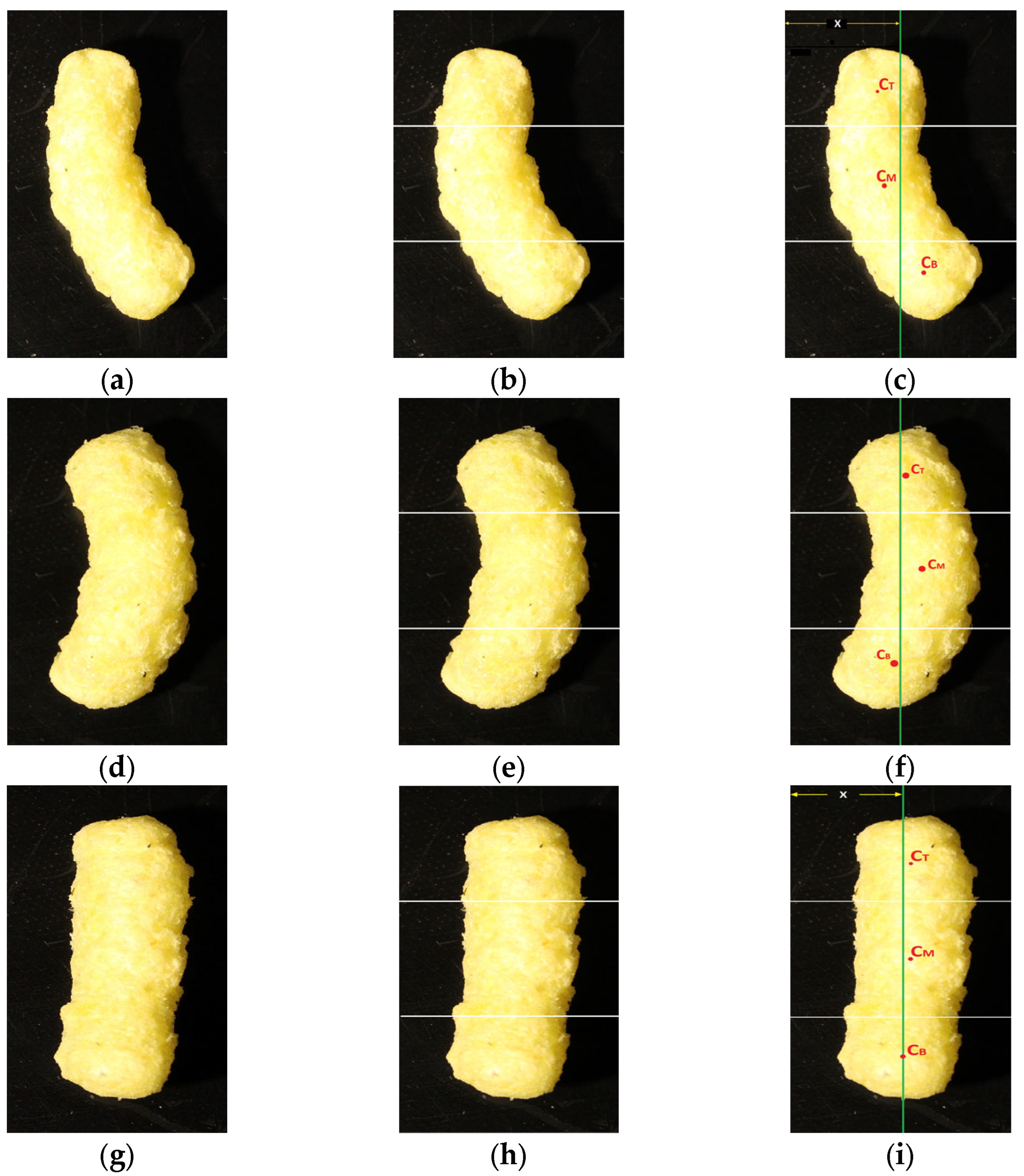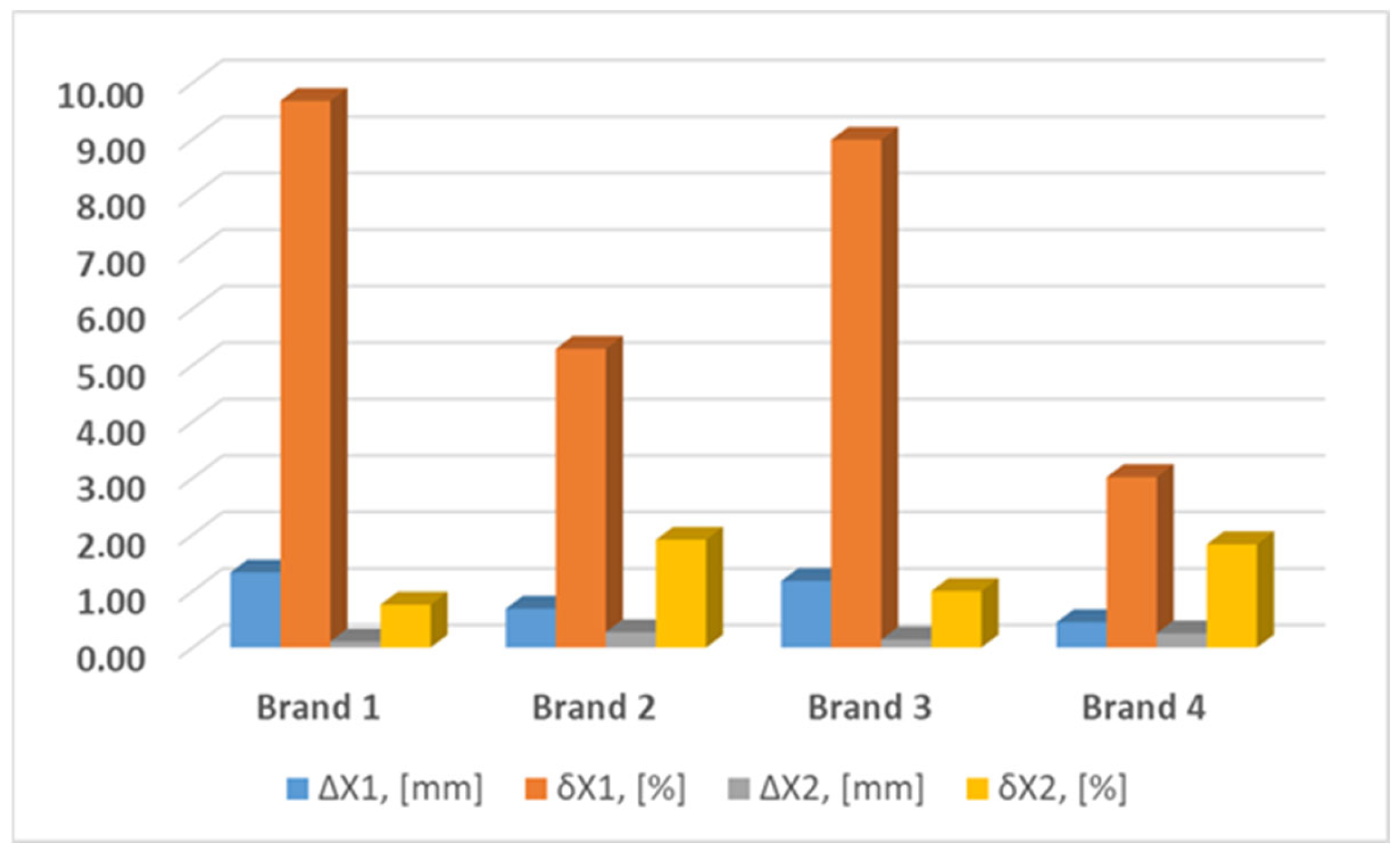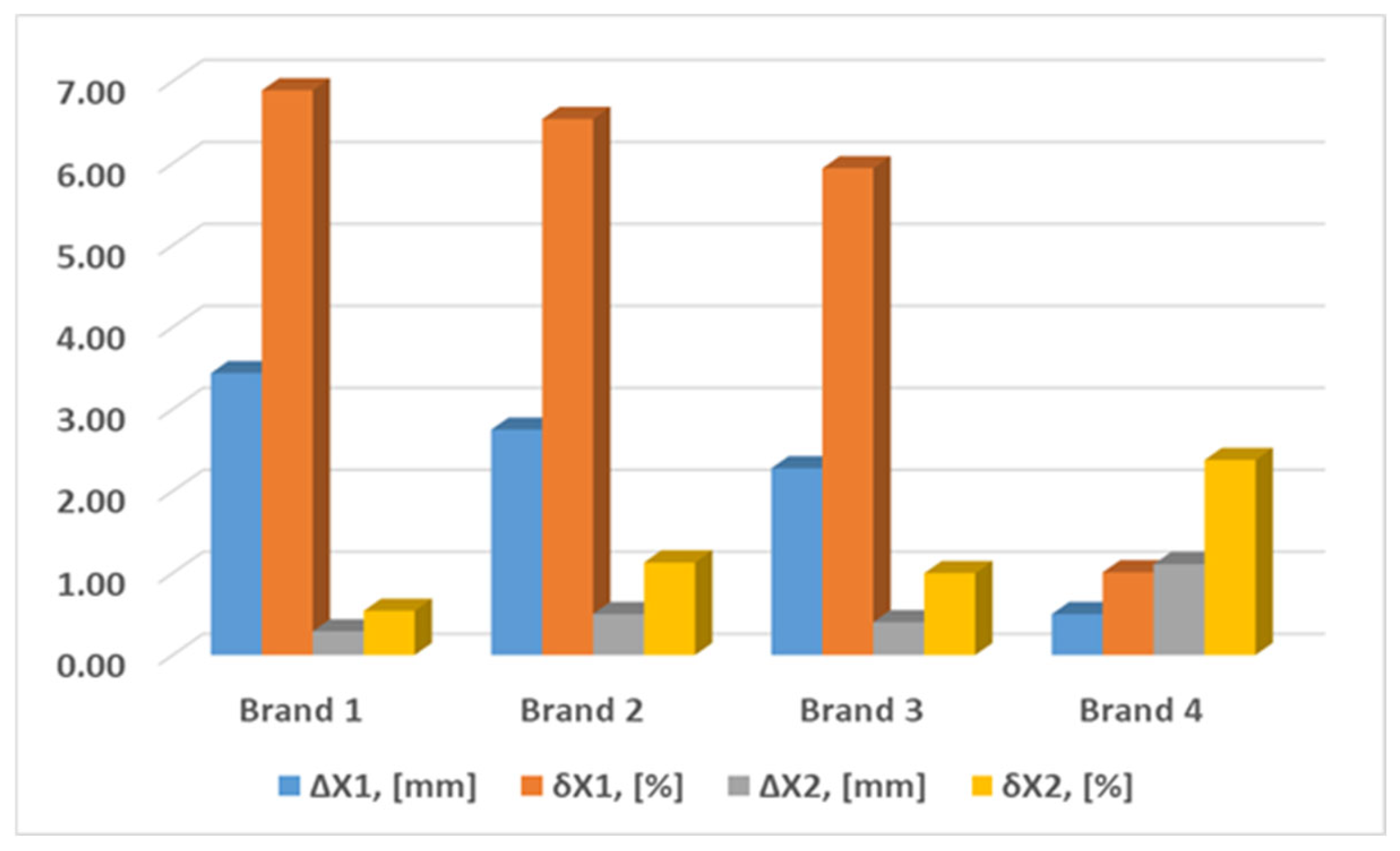Automatic Evaluation Visual Characteristics of Corn Snacks Using Computer Vision †
Abstract
1. Introduction
2. Materials and Methods
2.1. Extruded Foods
2.2. Reference Method
2.3. EFQVision—A System for Quality Control of Extruded Foods
2.4. Experimental Setting
2.5. Computer-Based Approach for Image Processing and Measurement
3. Results and Discussion
4. Conclusions
Author Contributions
Funding
Institutional Review Board Statement
Informed Consent Statement
Data Availability Statement
Acknowledgments
Conflicts of Interest
References
- Zhu, L.; Spachos, P.; Pensini, E.; Plataniotis, K.N. Deep learning and machine vision for food processing: A survey. Curr. Res. Food Sci. 2021, 4, 233–249. [Google Scholar] [CrossRef] [PubMed]
- Yi, C.; Qiang, N.; Zhu, H.; Xiao, Q.; Li, Z. Extrusion processing: A strategy for improving the functional components, physicochemical properties, and health benefits of whole grains. Food Res. Int. 2022, 160, 111681. [Google Scholar] [CrossRef] [PubMed]
- Kojić, J.; Belović, M.; Krulj, J.; Pezo, L.; Teslić, N.; Kojić, P.; Tukuljac, L.P.; Šeregelj, V.; Ilić, N. Textural, Color and Sensory Features of Spelt Wholegrain Snack Enriched with Betaine. Foods 2022, 11, 475. [Google Scholar] [CrossRef] [PubMed]
- Fan, F.H.; Ma, Q.; Ge, J.; Peng, Q.Y.; William, W.R.; Tang, S.Z. Prediction of texture characteristics from extrusion food surface images using a computer vision system and artificial neural networks. J. Food Eng. 2013, 118, 426–433. [Google Scholar] [CrossRef]
- Amer, S.A.; Rizk, A.E. Production and evaluation of novel functional extruded corn snacks fortified with ginger, bay leaves and turmeric powder. Food Prod. Process. Nutr. 2022, 4, 4. [Google Scholar] [CrossRef]
- Yizhou, M.; Potappel, J.; Chauhan, A.; Maarten, A.I.S.; Boom, R.M.; Zhang, L. Improving 3D food printing performance using computer vision and feedforward nozzle motion control. J. Food Eng. 2023, 339, 111277. [Google Scholar] [CrossRef]
- Chalamov, Y.; Simitchiev, A.; Nenov, V.; Danev, A.; Andreeva, H. Effect of propeller use on residence time distribution (rtd) in single-screw cam-flow rice semolina extrusion. BIO Web Conf. 2024, 102, 03003. [Google Scholar] [CrossRef]
- Finlayson, G.D. Colour and illumination in computer vision. Interface Focus 2018, 8, 4. [Google Scholar] [CrossRef] [PubMed]
- Ketelaere, B.D.; Wouters, N.; Kalfas, I.; Belleghem, R.V.; Saeys, W. A fresh look at computer vision for industrial quality control. Qual. Eng. 2022, 34, 152–158. [Google Scholar] [CrossRef]
- Schneider, C.A.; Rasband, W.S.; Eliceiri, K.W. NIH Image to ImageJ: 25 years of image analysis. Nat. Methods 2012, 9, 671–675. [Google Scholar] [CrossRef] [PubMed]
- Gabrova, R.; Danev, A.; Ganchovska, V.; Andreeva, H. Explore the possibilities for objective assessment of some beer quality indicators. IOP Conf. Ser. Mater. Sci. Eng. 2021, 1031, 012070. [Google Scholar] [CrossRef]
- Prodanov, D.; Verstreken, K. Automated Segmentation and Morphometry of Cell and Tissue Structures. Selected Algorithms in ImageJ. In Molecular Imaging; Schaller, B., Ed.; University of Paris-Sud: Gif-sur-Yvette, France, 2012; pp. 183–208. [Google Scholar] [CrossRef]









| Nutritional Value | Brand 1 | Brand 2 | Brand 3 | Brand 4 |
|---|---|---|---|---|
| Energy, kcal | 512 | 482 | 488 | 452 |
| Fats, g | 11.2 | 28.6 | 18.0 | 10.0 |
| Carbohydrates, g | 65.0 | 52.0 | 60.5 | 76.0 |
| Dietary fibbers, g | 1.8 | - | 1.4 | - |
| Protein, g | 5.5 | 6.6 | 11.3 | - |
| Slat, g | 1 | 1.5 | 1.2 | 0.5 |
| Sample № | Average Width, Caliper, [mm] | Average Width, ImageJ Tools, [mm] | Average Width, Automatic, [mm] | |
|---|---|---|---|---|
| Brand 1 | 1 | 13.90 | 14.90 | 15.10 |
| 2 | 13.17 | 15.18 | 15.02 | |
| 3 | 14.10 | 15.42 | 15.43 | |
| 4 | 13.63 | 14.96 | 15.04 | |
| 5 | 14.13 | 15.09 | 14.97 | |
| Brand 2 | 1 | 13.97 | 13.71 | 13.79 |
| 2 | 13.70 | 13.74 | 13.52 | |
| 3 | 13.13 | 14.58 | 13.80 | |
| 4 | 13.43 | 14.40 | 14.64 | |
| 5 | 12.67 | 13.96 | 13.91 | |
| Brand 3 | 1 | 12.93 | 15.05 | 15.08 |
| 2 | 13.13 | 14.55 | 14.11 | |
| 3 | 13.97 | 14.72 | 14.74 | |
| 4 | 13.20 | 14.05 | 13.93 | |
| 5 | 13.17 | 14.34 | 14.46 | |
| Brand 4 | 1 | 15.37 | 14.88 | 14.73 |
| 2 | 15.90 | 14.57 | 15.07 | |
| 3 | 12.68 | 12.39 | 12.61 | |
| 4 | 15.27 | 15.61 | 15.59 | |
| 5 | 12.82 | 13.59 | 13.21 |
| Sample № | Height, Caliper, [mm] | Height, ImageJ Tools, [mm] | Height, Automatic, [mm] | |
|---|---|---|---|---|
| Brand 1 | 1 | 51.70 | 55.05 | 55.44 |
| 2 | 48.05 | 51.10 | 51.39 | |
| 3 | 50.10 | 53.06 | 53.34 | |
| 4 | 44.10 | 46.89 | 46.75 | |
| 5 | 54.20 | 58.80 | 58.43 | |
| Brand 2 | 1 | 39.10 | 41.56 | 40.79 |
| 2 | 42.20 | 44.28 | 44.69 | |
| 3 | 45.10 | 47.87 | 48.54 | |
| 4 | 40.50 | 43.39 | 44.01 | |
| 5 | 42.60 | 45.19 | 45.23 | |
| Brand 3 | 1 | 37.50 | 40.14 | 40.35 |
| 2 | 38.30 | 40.29 | 40.84 | |
| 3 | 42.90 | 43.71 | 43.95 | |
| 4 | 38.40 | 40.85 | 41.33 | |
| 5 | 37.40 | 38.88 | 39.41 | |
| Brand 4 | 1 | 46.50 | 46.88 | 47.08 |
| 2 | 52.90 | 46.70 | 51.80 | |
| 3 | 45.00 | 44.90 | 44.91 | |
| 4 | 49.00 | 49.70 | 49.66 | |
| 5 | 48.00 | 47.70 | 47.91 |
| Caliper | ImageJ Tools | Automatic | |
|---|---|---|---|
| Caliper | 1 | ||
| ImageJ tools | 0.47 | 1 | |
| Automatic | 0.57 | 0.94 | 1 |
| Caliper | ImageJ Tools | Automatic | |
|---|---|---|---|
| Caliper | 1 | ||
| ImageJ tools | 0.91 | 1 | |
| Automatic | 0.96 | 0.98 | 1 |
Disclaimer/Publisher’s Note: The statements, opinions and data contained in all publications are solely those of the individual author(s) and contributor(s) and not of MDPI and/or the editor(s). MDPI and/or the editor(s) disclaim responsibility for any injury to people or property resulting from any ideas, methods, instructions or products referred to in the content. |
© 2025 by the authors. Licensee MDPI, Basel, Switzerland. This article is an open access article distributed under the terms and conditions of the Creative Commons Attribution (CC BY) license (https://creativecommons.org/licenses/by/4.0/).
Share and Cite
Danev, A.; Bosakova-Ardenska, A.; Gabrova, R.; Andreeva, H. Automatic Evaluation Visual Characteristics of Corn Snacks Using Computer Vision. Eng. Proc. 2025, 104, 81. https://doi.org/10.3390/engproc2025104081
Danev A, Bosakova-Ardenska A, Gabrova R, Andreeva H. Automatic Evaluation Visual Characteristics of Corn Snacks Using Computer Vision. Engineering Proceedings. 2025; 104(1):81. https://doi.org/10.3390/engproc2025104081
Chicago/Turabian StyleDanev, Angel, Atanaska Bosakova-Ardenska, Radoslava Gabrova, and Hristina Andreeva. 2025. "Automatic Evaluation Visual Characteristics of Corn Snacks Using Computer Vision" Engineering Proceedings 104, no. 1: 81. https://doi.org/10.3390/engproc2025104081
APA StyleDanev, A., Bosakova-Ardenska, A., Gabrova, R., & Andreeva, H. (2025). Automatic Evaluation Visual Characteristics of Corn Snacks Using Computer Vision. Engineering Proceedings, 104(1), 81. https://doi.org/10.3390/engproc2025104081






